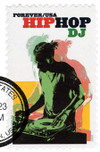
# 5483 - 2020 First-Class Forever Stamp - Hip Hop: DJ
US #5483
2020 DJ at Turntable – Hip Hop
• One of four stamps commemorating the creativity and far-reaching influence of hip hop on the world of music
Stamp Category: Commemorative
Set: Hip Hop
Value: 55¢ First Class Mail Rate (Forever)
First Day of Issue: July 1, 2020
First Day City: New York, New York
Quantity Issued: 20,000,000
Printed by: Ashton Potter (USA) Ltd.
Printing Method: Offset
Format: Panes of 20
Tagging: Nonphosphored Type III, Block Tag
Why the stamp was issued: To recognize the importance of DJing to the genre of hip hop music.
About the stamp designs: Pictures a photograph of a DJ at a turntable taken by Cade Martin and accented by digital tinting (yellow, green, red, and black) to make the image appear to be in motion.
First Day City: There was no First Day of Issue Ceremony for these stamps, but the First Day of Issue Cancellation was from New York City.
About the Hip Hop set: Four stamps celebrating the legacy of hip hop music and its influence on American and world popular culture. All picture photographs taken by Cade Martin that have been accentuated by digital tinting (yellow, green, red, and black) to make them appear to be in motion.
History the stamp represents: As the backbone of a hip hop performance, the DJ provides the music and the beat for the MC to sing over and the b-boys to dance to.
The term DJ (disc jockey) was coined in 1935 to describe famed radio announcer Martin Block. The first dance parties hosted by DJs came in the 1940s, as did the first use of two turntables for continuous music. By the 1960s, specialized equipment intended for use by DJs began to appear. This helped develop the practice of beatmatching, in which DJs could transition seamlessly between songs with matching beats.
In the 1970s, hip hop pioneer DJ Kool Herc developed the technique of mixing between two records to lengthen the instrumental section. This marked the rise of turntablism, in which the turntables didn’t just play music, they also created sounds and new music. This led to hip hop’s signature scratching technique. Scratching is the practice of moving a record back and forth on the turntable to create new rhythmic sounds. There are a variety of scratching techniques that all create their own unique sounds.
The DJ’s role in hip hop is crucial. Their work requires both artistic talent and technical skill to create seamless music – beatmatching to blend songs together. When executed well, the DJ creates an exciting experience for audiences and dancers alike.
US #5483
2020 DJ at Turntable – Hip Hop
• One of four stamps commemorating the creativity and far-reaching influence of hip hop on the world of music
Stamp Category: Commemorative
Set: Hip Hop
Value: 55¢ First Class Mail Rate (Forever)
First Day of Issue: July 1, 2020
First Day City: New York, New York
Quantity Issued: 20,000,000
Printed by: Ashton Potter (USA) Ltd.
Printing Method: Offset
Format: Panes of 20
Tagging: Nonphosphored Type III, Block Tag
Why the stamp was issued: To recognize the importance of DJing to the genre of hip hop music.
About the stamp designs: Pictures a photograph of a DJ at a turntable taken by Cade Martin and accented by digital tinting (yellow, green, red, and black) to make the image appear to be in motion.
First Day City: There was no First Day of Issue Ceremony for these stamps, but the First Day of Issue Cancellation was from New York City.
About the Hip Hop set: Four stamps celebrating the legacy of hip hop music and its influence on American and world popular culture. All picture photographs taken by Cade Martin that have been accentuated by digital tinting (yellow, green, red, and black) to make them appear to be in motion.
History the stamp represents: As the backbone of a hip hop performance, the DJ provides the music and the beat for the MC to sing over and the b-boys to dance to.
The term DJ (disc jockey) was coined in 1935 to describe famed radio announcer Martin Block. The first dance parties hosted by DJs came in the 1940s, as did the first use of two turntables for continuous music. By the 1960s, specialized equipment intended for use by DJs began to appear. This helped develop the practice of beatmatching, in which DJs could transition seamlessly between songs with matching beats.
In the 1970s, hip hop pioneer DJ Kool Herc developed the technique of mixing between two records to lengthen the instrumental section. This marked the rise of turntablism, in which the turntables didn’t just play music, they also created sounds and new music. This led to hip hop’s signature scratching technique. Scratching is the practice of moving a record back and forth on the turntable to create new rhythmic sounds. There are a variety of scratching techniques that all create their own unique sounds.
The DJ’s role in hip hop is crucial. Their work requires both artistic talent and technical skill to create seamless music – beatmatching to blend songs together. When executed well, the DJ creates an exciting experience for audiences and dancers alike.








